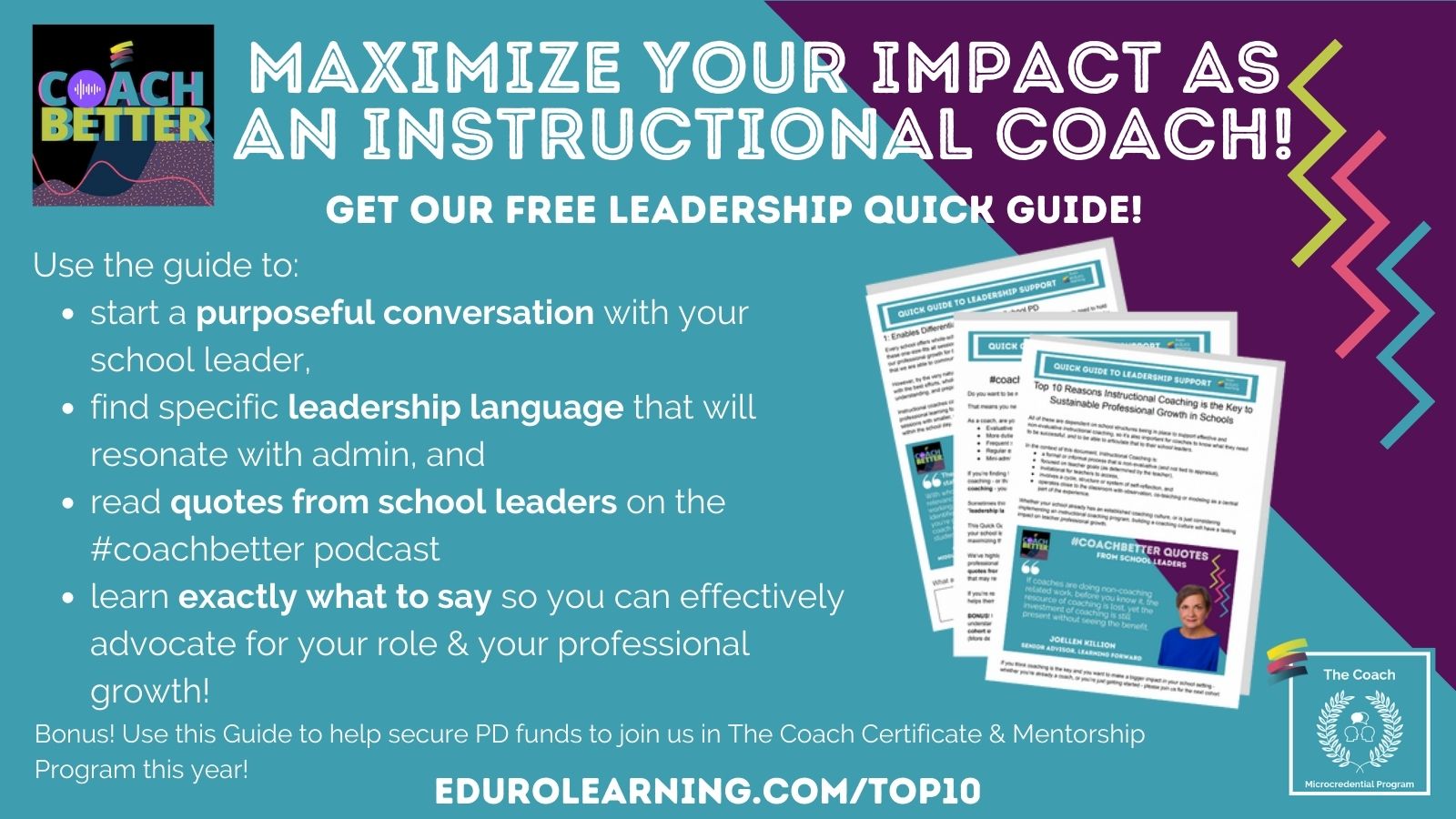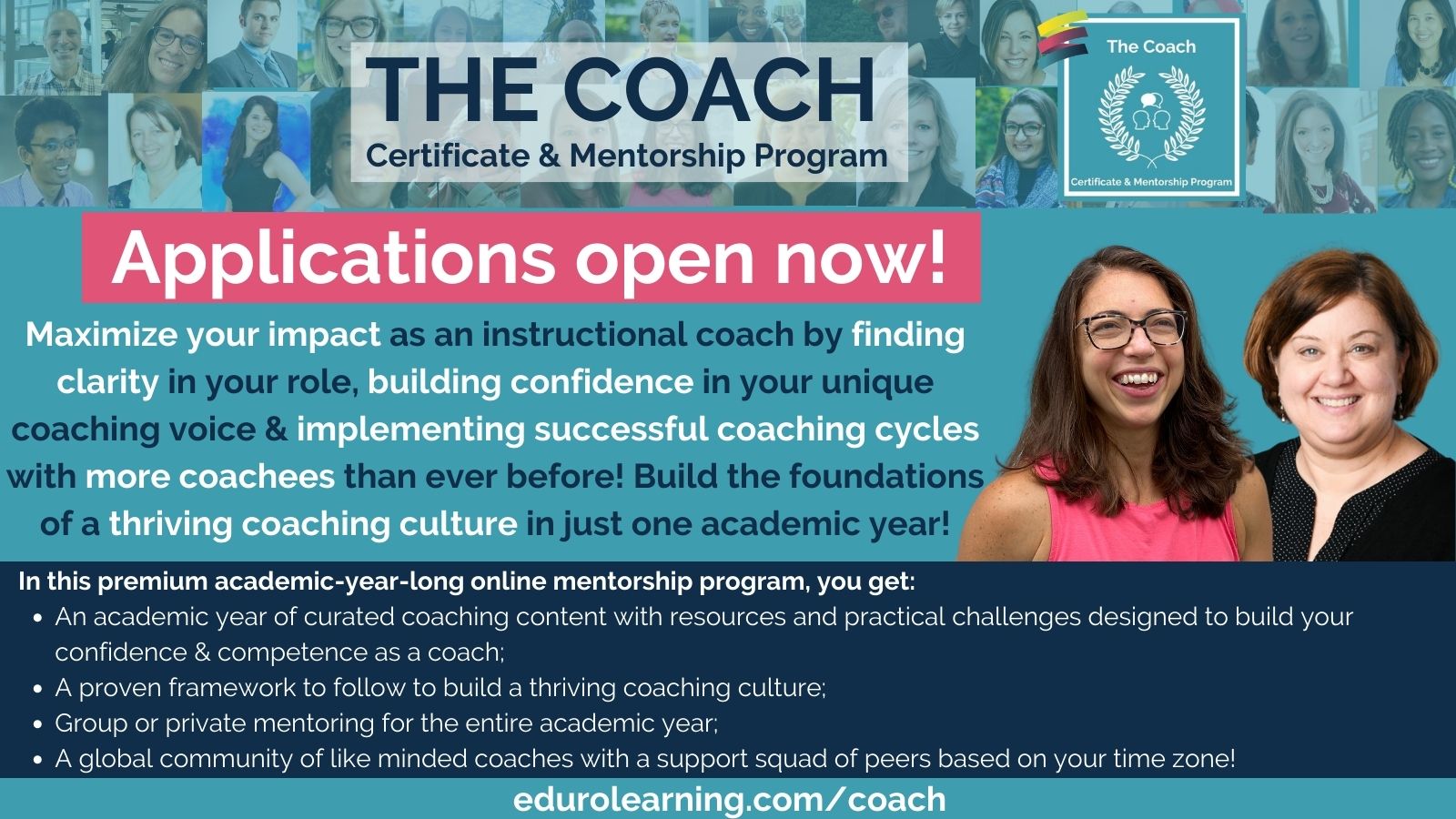A topic that comes up regularly among coaches is around their role of “classroom supporter” which coaching experts Joellen Killion and Cindy Harrison include in their list of Ten Roles and Responsibilities of Coaches. In Coaching Matters, they share that the purpose of this role is about coaches working inside the classroom in a variety of ways to “enhance teachers’ efficacy and improve teaching and student learning.”
One of the major benefits instructional coaches provide to their school community is through their direct work with teachers and students, impacting teaching and learning in the classroom. For this to happen in a productive way, coaches need to be in classrooms. However, a variety of factors can influence how successful coaches are in engaging teachers in coaching cycles that address and impact student learning.
Some schools have clearly defined expectations of how teachers and coaches work together. However, some coaches are in environments where their role is not clearly defined or they are expected to take the initiative in cultivating coaching opportunities themselves.
I’ve heard from many coaches in these situations, and experienced it myself, regarding the challenges of “getting into classrooms” to support teachers and students. What I’ve learned from my own experience is the need to utilize some public relations and marketing strategies to engage teachers in collaborating with a coach.
The goal of these strategies is to cultivate opportunities for coaching conversations focused on student learning which then lead to action.
When you think about ‘working inside the classroom in a variety of ways’ are you wondering about how to make that a reality? Are you finding that you need a variety of strategies to get into more classrooms as a coach? To overcome any reluctance or fear about coaching?
We support you with all of this inside The Coach Certificate & Mentorship Program! In Phase 1, Finding Clarity, we help you articulate and define your role so you can create a coaching menu for your teachers. In Phase 2, Implement Consistently, we focus on building your coaching skills so you can confidently approach all the teachers you work with! And in Phase 3, we help you grow your coaching culture beyond working with the willing. By the end of the program, you’ll be working with more teachers than ever before!
5 Strategies to Get Into More Classrooms as an Instructional Coach
Today, I’ll share five strategies that you can use in to engage teachers and teams in coaching cycles and get yourself into classrooms working with teachers and students. We use all of these strategies in The Coach Certificate and Mentorship Program too – so if you’d like support as you give them a try, come join us in the next global cohort!
1: Communicate your role clearly and consistently.
This is key! Make connections to school mission, vision, and goals to let people know how your role is supporting what is important to your school community. Also, engage leadership in conversations to ensure agreement and understanding about coaching in your school and how they can promote and support your work with teachers and students.
2: Share and model the ways that working with a coach can benefit teaching and learning in the classroom
You may need to help educate your colleagues on how coaching benefits them and their students by providing examples and ideas about working with a coach. We know there are teachers who are interested in working with a coach but not sure how it might work. You can share and model what coaching looks like through mini PD sessions, coaching menus, and coaching models.
3: Initiate conversations with colleagues about working with them and their students
This can be done school-wide, with teams, and with individual teachers. Finding opportunities to discuss your role can happen through formal meetings and through informal chats. As you build relationships and dig deeper into curriculum and initiatives with colleagues, you can find entry points into discussions about how you can provide support and guidance on specific areas of learning.
Do you want to be making the biggest impact you can, as an instructional coach?
That means you need to be spending your time actually coaching!

As a coach, are you finding yourself asked to do:
- Evaluative observation or feedback?
- More duties than any other teacher?
- Frequent sub cover?
- Regular exam monitoring?
- Mini-admin tasks, like organizing meetings or schedules?
If you’re finding that your schedule is frequently bombarded with things that aren’t actually coaching – or that you and your school leader are not aligned on the vision and practice of coaching – you may need to work towards clarity.
Sometimes this can be really challenging because, as coaches, we don’t always have the “leadership language” to talk about these kinds of big picture ideas.
This Quick Guide gives you the leadership language to have a purposeful conversation with your school leaders about investing in YOUR professional growth as a coach, and therefore maximizing the impact you can make in your school setting.
We’ve highlighted the top 10 reasons that instructional coaching is the key to sustainable professional growth in schools, from a school leaders perspective AND we’ve included key quotes from the #coachbetter podcast with school leaders, so you have the exact language that may resonate well with your school leaders.
If you’re ready to have this conversation with your school leaders, you may find this resource helps them understand why coaching is so valuable.
Get it for FREE here: https://edurolearning.com/quickstart
BONUS! Use the quotes & rationale inside this Quick Guide to help your school leader understand why they should invest PD funds to support you in joining our next global cohort of The Coach Certificate & Mentorship Program – which opens for registration soon!
4: Find ways that you and your colleagues can use data to focus on areas of growth for students
This can be done through observations to gather data via strategies such as Looking for Learning or learning walks. Any involvement in assessment reviews or dialogues around data about student learning will reveal focus points for collaboration with teachers. Look for what is working in student learning as well as where there might be areas of growth which can lead to productive conversations about where to focus in the classroom.
5: Celebrate and share your work with teachers and students with your school community
Circling back to strategy two about sharing and modeling what coaching looks like in the classroom. Find ways to acknowledge and, where appropriate, share what’s happening in the classrooms you are working with – the successes and the learning. Seeing how you work with your colleagues can encourage others to seek out your advice, support, and collaboration. Of course, you can take the initiative in how and when you share these experiences. But even better is when your can build confidence and capacity for teachers to celebrate and share their own successes.
While it may be up to you build or expand the coaching culture at your school, you can use these strategies to be more visible and interactive in classrooms. No matter how your school approaches and supports the role of the coach, you will need to be proactive and strategic in how you interact with your colleagues in this role. However, when you make the effort, the opportunities for you, and more importantly the teachers and students, will be meaningful and lead to even more amazing opportunities.
Watch the Video
Get into MORE classrooms as an Instructional Coach with the support of The Coach Certificate & Mentorship Program!
If you are ready to get into MORE classrooms than every before as a coach, and you’d like some support in making that happen, everything that Diana shared today is part of what we do inside The Coach Certificate and Mentorship Program.

The first phase of the program is called Finding Clarity, because we know how important it is, not only for you to truly have a deep knowledge of what coaching is, and what it isn’t, but because we know you want the confidence to be able to share that with others. Everything from defining your role (for yourself, your school leaders and your colleagues) to creating a coaching menu is included in Phase 1, so you can start from wherever you are in your school setting and take that next step forward. Defining & articulating your role clearly & confidently to others is a HUGE step forward in working towards engaging more teachers in more coaching cycles.
If this sounds interesting to you, and you’re ready to have more clarity in your role, so you can work with more teachers than ever before, come join us in the next global cohort of The Coach Certificate and Mentorship Program!
Not only will you learn everything you need to be successful as a K12 instructional coach, with an entire academic year of curated coaching content, but you’ll also get the support of a mentor to adapt your learning to exactly your needs & experience level for the entire program!
The program is truly personalized – because we know you’re coming to The Coach with your own experience and expertise. So wherever you are in your coaching journey, we can support you in taking the next step forward.
Plus, inside our private community, you’ll learn with a global cohort of coaches from schools around the world, so you can see how coaching really works in other schools – and build your network of coaches!
Our global cohorts open only once a year – get all the details for our next cohort at edurolearning.com/coach

Recent Comments